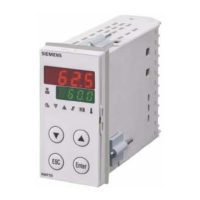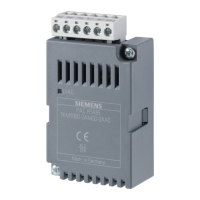16/126
Siemens Building Technologies Basic documentation RVD240 CE1P2384en
HVAC Products 2 Use 27.05.2004
• Maximum rate of flow temperature increase
• Minimum and maximum limitation of the flow temperature
• Maximum limitation of the room temperature
• Flow alarm
• Heat demand signal can be received
• Differential temperature limitation (DRT function)
• Maximum limitation of the primary return temperature, can be adjusted with 4 vari-
ables
• Limitation of power or volumetric flow by pulses
• Suppression of hydraulic creep in the primary circuit
• Weather-compensated raising of the reduced room temperature setpoint
• Remote operation via room unit
2.5 D.h.w. functions
The RVD240 is used if one or several of the following d.h.w. functions is / are required:
• Common or separate heat exchangers for the heating circuit and for d.h.w. heating
• D.h.w. heating with a coil type storage tank, with charging pump
• Direct d.h.w. heating via heat exchanger
• D.h.w. heating with coil type or stratification storage tanks, with or without mixing
valve in the intermediate circuit
• Continuous d.h.w. heating with mixing valve
• Flow switch with an adjustable load limit, child-proofing and adaptation to the season
• Own time program for the release of d.h.w.
• Optional assignment of the circulating pump to the heating circuit or the d.h.w. circuit
time program
• Protection against cooling down with d.h.w. heating via heat exchanger
• Legionella protection
• Forced d.h.w. charging
• frost protection for d.h.w.
• Selectable priority for d.h.w. heating : Absolute, shifting or parallel
• Manual d.h.w. charging outside the time program
• Maximum limitation of the d.h.w. return temperature
• Flow alarm
2.6 Auxiliary functions
The RVD240 is used if one or several of the following functions is / are required:
• Pump kick, periodic pump run
• Demand-dependent control of the common flow
• Pump overrun
• Valve kick, periodic activation of all actuators on the secondary side
• PWM output, control of a variable speed pump
• Display of parameters, actual values, operating states and fault status signals
• Alarm input
• Analog input DC 0...10 V (display, external heat demand)
• Digital input (heat meter, external heat demand, etc.)
• Flow switch (including child-proofing and adaptation to the season)
• Communication via M-bus
• Communication via LPB (Local Process Bus)
• Service functions
• Pulse lock for actuators
• Sensor test

